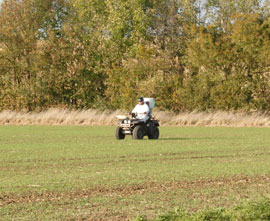Concern grows over high metaldehyde levels

Metaldehyde concentrations in UK watercourses have been recorded as much as 40 times over the EU standard for drinking water in the past three weeks, figures show.
Water UK, the umbrella organisation for the water utility companies, said measurements of the chemical used in slug pellets were more than 4ppb – the highest levels measured since intensive monitoring began four years ago.
Phill Mills, of Water UK, said the levels greatly exceeded the 0.1ppb standard for drinking water set by EU legislation, and he added that metaldehyde levels in both raw and treated water were causing concern this year.
“Water companies in all areas of the country – with the exception of the North West – have reported excesses in the past three weeks,” said Mr Mills.
“Not only are levels higher than they were in 2008, the detection of metaldehyde in water is more widespread than before.”
Knowing whether the current situation is just a spike, or if it is likely to continue beyond three weeks, is the key concern for the water companies, he added.
“If it continues, it’s more difficult for them to manage,” explained Mr Mills. “Currently, metaldehyde levels are above EU limits but a very long way below human health standards.”
He recognised that the exceptionally difficult year was having an influence. “The very wet conditions are making it almost impossible for farmers to use cultural control methods and to time slug pellet applications to avoid rainfall events.”
Measures put in place in 2008 by the Metaldehyde Stewardship Group (MSG) have been effective, he acknowledged. “Since then, there has been a downward trend in the number of incidences of metaldehyde being found in raw and treated water.
“But the climatic conditions are so challenging this year that it appears these voluntary measures are being stretched.”
MSG chairman David Cameron said that the situation was of huge concern and was being taken very seriously.
“We are committed to working with the water industry and growers to come up with sustainable solutions and to prevent problems occurring,” he said.
Stewardship measures must be observed, despite the very high slug pressure, he added.
NFU combinable crops chairman Andrew Watts urged growers to think carefully about their use of metaldehyde, for fear of losing the product for good. “It is probably better to lose a proportion of the crop around the headlands than it is to not have that product at all next year. It is very difficult but it is much better to have the tool [metaldehyde] available in the future.”
Slug pressure remains extremely high this season and some soils have already reached field capacity. The most significant risk of metaldehyde losses into surface waters occurs when field drains are flowing. In these cases, best practice guidelines state that metaldehyde should not be applied.
The Environment Agency said metaldehyde in water did not pose a risk to human health. But higher levels could still put the UK at risk of breaching the requirements of the EU Drinking Water Directive (DWD) and Water Framework Directive, it warned.
Guidelines suggest aiming for good slug control while keeping crop damage at an acceptable level and using the minimum amount of active ingredient.
But it won’t be easy. Paul Fogg, of the Metaldehyde Stewardship Group (MSG), said: “Growers are facing a very difficult task this season.”
Many growers have been calling the MSG hotline enquiring whether the 210g metaldehyde/ha is a statutory requirement or an advisory rate.
“The 210g/ha rate is advisory, but given the pressure this season, growers should be considering the advice as statutory if they want to keep metaldehyde in the armoury,” Dr Fogg explained.
More on slug pellet best practice

